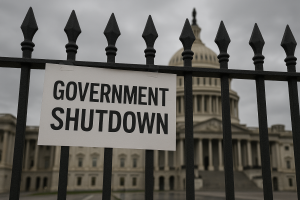The Department of Education’s (ED) 2025–26 negotiated rulemaking cycle is poised to reshape the architecture of Title IV federal student aid, following Congress’s recent passage of the One Big Beautiful Bill Act (OBBB). At the center of this overhaul, taking effect on July 1, 2026, sits the AHEAD Committee (Accountability in Higher Education and Access through Demand-driven Workforce Pell), tasked with translating major statutory changes into the regulatory language that institutions will ultimately need to follow. In short: now that we have the law, how are we going to enforce it.
Significant public attention has focused on the loan-cap debates emerging from the parallel Reimagining and Improving Student Education (RISE) Committee, which recently reached consensus on the Department’s draft regulatory language defining “professional degree.” However, the most important aspect of this entire process is understanding the difference between what Congress wrote into statute (Public Law 119-21) and what the Department must now implement through the Code of Federal Regulations, such as updates to 34 CFR Parts 685, 668, and 690. That statutory–regulatory interplay is where the real complexity and the real policy impact will unfold.
What Is Negotiated Rulemaking (NegReg)?
AHEAD faces the difficult and enormously consequential mission of implementing:
- Sweeping changes to institutional and programmatic accountability, including the potential loss of Direct Loan eligibility for programs that produce low earnings outcomes for two out of three years after graduation, as well as the integration of the new Financial Value Transparency framework and a rearticulated Gainful Employment standard;
- Establishing eligibility requirements for the new Workforce Pell Grant, which applies to short-term workforce programs lasting 8–15 weeks, stackable into a recognized postsecondary credential or degree, approved by a state governor, and demonstrating strong labor-market outcomes;
- Defining the new exclusion criteria for Pell Grant recipients, including students receiving aid packages that fully cover cost of attendance or whose Student Aid Index exceeds twice the maximum Pell award; and
- Implementing the remaining provisions of Public Law 119-21 that were not already addressed in the Department’s July 18, 2025 Dear Colleague Letter.
This article focuses on Issue #1: the core accountability framework; defining what constitutes low earnings; how Financial Value Transparency will operate; how Gainful Employment will be re-conceptualized; and what these measures ultimately mean for an institution’s continued participation in the Direct Loan program.
Obviously, representatives from community colleges, private nonprofit universities, and for-profit universities, will have serious input on how the Department defines what is essentially a ‘successful’ educational institution (one deserving of government subsidies) and an ‘unsuccessful’ educational institution (one undeserving of those subsidies). That’s exactly why each sector has an appointed negotiator sitting at the drafting table. These definitions aren’t abstract; they directly affect who gets access to billions in federal dollars and who does not.
But before getting into the regulatory nuance and statutory interpretation, we must go back and understand how we, as a Nation, ended up in a place where almost no modern educational institution can operate without Title IV eligibility.
The bar Congress has set isn’t even high. At minimum, schools should be able to tell prospective students what a program costs, how many graduates secure and retain meaningful employment, and what those graduates end up earning. This is by no means radical oversight; rather, this is the most elementary form of consumer transparency. Yet reaching this point required a full political rupture, because for decades higher education has operated with very few significant guardrails, leaving students, taxpayers, and even responsible institutions on the hook for absorbing schools’ runaway administrative costs. As I have written previously in the Veterans Law Journal, warning of some bad actors that treat Student Veterans as, “walking dollar signs.”
This is why the Department (of Education) has not just asked for negotiators from the big three, it has also asked for Primary and Alternate negotiators to represent the interests of the following groups:
- Student loan servicers, collection agencies, lenders, and guaranty agencies;
- State officials, including state student grant agencies, state higher education executive officers, and representatives of state authorizing agencies;
- Legal assistance organizations that represent students and borrowers, consumer advocates, and civil rights groups that represent students;
- Student loan borrowers, including borrowers in school, deferment, forbearance, delinquent, default, and currently in repayment;
- Organizations representing taxpayers and the public interest; and
- Student loan borrowers who are veterans, U.S. military service members, or groups representing them (who are represented by this author as Primary, and Ms. Julie Howell of Paralyzed Veterans of America as Alternate).
Over the years, some schools have served Student Veterans very well, unfortunately, that is not always the case. Regulations in the past had not protected all Student Veterans across higher education and we welcome the new metrics that the Department is implementing that will serve Veterans regardless of where they choose to attend school.
Currently, institutional eligibility for participating in any student financial assistance program authorized by Title IV of the Higher Education Act of 1965 is defined in Title 34, Part 600 of the Code of Federal Regulations, principally in 34 C.F.R. §§ 600.2 and 600.4–600.6, and further supported by the student-assistance provisions found in 34 C.F.R. Part 668, which govern the conditions institutions must meet to maintain Title IV participation. These regulations are published by the National Archives and Records Administration (NARA) through the Office of the Federal Register.
Using the eCFR (Getting Started), online readers can easily find controlling regulatory language, its citation, its revision history, and its most recent amendments, even comparing versions of a regulation across different dates. This extraordinary tool also links each regulation directly to its statutory authority under the United States Code (U.S.C.), which is the federal government’s codified, organized version of the slip laws enacted by Congress (e.g., Public Law 119-21).
For institutional eligibility, Congress amended the Higher Education Act’s provision on Ineligibility Based on Low Earnings Outcomes via Section 84001 of Subtitle E—Accountability (Pub. L. 119-21, § 84001, 139 Stat. 353 (2025)). Specifically, Congress amended Section 454 of the Higher Education Act of 1965 (20 U.S.C. 1087d) and inserted:
(c) Ineligibility for Certain Programs Based on Low Earning Outcomes
(1) In general.
Notwithstanding section 481(b), an institution of higher education subject to this subsection shall not use funds under this part for student enrollment in an educational program offered by the institution that is described in paragraph (2).
(2) Low-earning outcome programs described.
An educational program at an institution is described in this paragraph if the program awards an undergraduate degree, graduate or professional degree, or graduate certificate, for which the median earnings (as determined by the Secretary [of the U.S. Department of Education]) of the programmatic cohort of students who received funds under this title for enrollment in such program, who completed such program during the academic year that is 4 years before the year of the determination, who are not enrolled in any institution of higher education, and who are working, are, for not less than 2 of the 3 years immediately preceding the date of the determination, less than the median earnings of a working adult described in paragraph (3) for the corresponding year.
(3) Calculation of median earnings.
(A) Working adult.
For purposes of applying paragraph (2) to an educational program at an institution, a working adult described in this paragraph is a working adult who, for the corresponding year (i) is aged 25 to 34; (ii) is not enrolled in an institution of higher education; and (iii)(I) in the case of a determination made for an educational program that awards a baccalaureate or lesser degree, has only a high school diploma or its recognized equivalent; or (II) in the case of a determination made for a graduate or professional program, has only a baccalaureate degree.
(B) Source of Data
Source of data. For purposes of applying paragraph (2) to an educational program at an institution, the median earnings of a working adult, as described in subparagraph (A), shall be based on data from the Bureau of the Census—(i) with respect to an educational program that awards a baccalaureate or lesser degree—(I) for the State in which the institution is located; or (II) if fewer than 50 percent of the students enrolled in the institution reside in the State where the institution is located, for the entire United States; and (ii) with respect to an educational program that is a graduate or professional program
(I) for the lowest median earnings of—(aa) a working adult in the State in which the institution is located; (bb) a working adult in the same field of study (as determined by the Secretary, such as by using the 2-digit CIP code) in the State in which the institution is located; and (cc) a working adult in the same field of study (as so determined) in the entire United States; or (II) if fewer than 50 percent of the students enrolled in the institution reside in the State where the institution is located, for the lower median earnings of—(aa) a working adult in the entire United States; or (bb) a working adult in the same field of study (as so determined) in the entire United States.
(4) Small programmatic cohorts.
For any year for which the programmatic cohort described in paragraph (2) for an educational program of an institution is fewer than 30 individuals, the Secretary shall (A) first, aggregate additional years of programmatic data in order to achieve a cohort of at least 30 individuals; and (B) second, in cases in which the cohort (including the individuals added under subparagraph (A)) is still fewer than 30 individuals, aggregate additional cohort years of programmatic data for educational programs of equivalent length in order to achieve a cohort of at least 30 individuals.
(5) Appeals process.
An educational program shall not lose eligibility under this subsection unless the institution has had the opportunity to appeal the programmatic median earnings of students working and not enrolled determination under paragraph (2), through a process established by the Secretary. During such appeal, the Secretary may permit the educational program to continue to participate in the program under this part.
(6) Notice to students.
(A) In general. If an educational program of an institution of higher education subject to this subsection does not meet the cohort median earning requirements, as described in paragraph (2), for one year during the applicable covered period but has not yet failed to meet such requirements for 2 years during such covered period, the institution shall promptly inform each student enrolled in the educational program of the eligible program’s low cohort median earnings and that the educational program is at risk of losing its eligibility for funds under this part.
(B) Definition.
Covered period. In this paragraph, the term ‘covered period’ means the period of the 3 years immediately preceding the date of a determination made under paragraph (2).
(7) Process.
Regaining programmatic eligibility. The Secretary shall establish a process by which an institution of higher education that has an educational program that has lost eligibility under this subsection may, after a period of not less than 2 years of such program’s ineligibility, apply to regain such eligibility, subject to the requirements established by the Secretary that further the purpose of this subsection.
Congress did not define the mechanics, formulas, data sources, reporting requirements, timelines, enforcement triggers, appeal standards, reinstatement conditions, or student-notification protocols. Instead, Congress laid out the statutory skeleton and now expects the AHEAD Committee to negotiate and define the specific regulatory language that make the Committee’s policy function in the real world.
To be explicit, here are the core elements that Congress requires the Department to define through regulation:
- How “median earnings” will be calculated, including:
- which federal data systems will be used (IRS? SSA? Census?)
- how earnings will be adjusted for inflation and year-to-year comparability
- how to treat non-filers, part-time workers, military, gig workers, or self-employed graduates
- whether suppressed or incomplete datasets trigger proxies or exclusions
- How programmatic cohorts will be constructed, including:
- how ED determines who “completed” a program
- how to classify students who transfer, stop out, reenroll, or stack credentials
- how to assign students to CIP codes and credential levels
- How the “2 out of 3 years” failure threshold will be measured, including:
- whether missing data counts as failure
- how often determinations occur
- how timing aligns with aid cycles and eligibility renewals
- The process for small-cohort aggregation, including:
- what “equivalent length” means
- how many years may be rolled together
- whether aggregation is mandatory or optional
- The appeals process, including:
- what evidence institutions may submit
- whether appeals pause sanctions
- who adjudicates appeals and under what standard
- The student notification requirements, including:
- timing, wording, format, and delivery method
- whether disclosures must appear in catalogs, financial-aid offers, marketing, or enrollment agreements
- consequences for failure to notify
- The reinstatement process for failed programs, including:
- what data must be demonstrated to regain eligibility
- whether probationary periods or provisional certification apply whether reinstated programs face heightened monitoring
What happens next is not merely wordsmithing. It is a high-stakes exercise in regulatory physics, where a single definition, a single modifier, or a single data assumption can shift hundreds of institutions into or out of eligibility.
For example, imagine the Department tweaks the phrase “median earnings” to “mean earnings.” On paper, it looks trivial, only four letters change; but in practice? The mean is easily skewed upward by a handful of high earners, while the median is not. If mean earnings were used instead, a program whose graduates overwhelmingly earn $38,000 a year could appear to earn $55,000 simply because three students landed lucrative tech or defense jobs. That one substitution would instantly protect programs that Congress clearly intended to hold accountable and it would cost universities whose programs actually produce equitable middle-class outcomes millions in lost enrollment, lost federal aid, lost operating revenue, and lost public trust.
This is why the wording matters. This is why AHEAD matters. And this is why the negotiation that follows will be the most consequential regulatory exercise in higher education in more than a decade. When the proposed rule is published, the public must look for the pressure points: how earnings are calculated, how programs are classified, how small cohorts are aggregated, how appeals are structured, how disclosures are delivered, and how “ineligibility” is defined. Because buried in those clauses, commas, and cross-references will be the future of which institutions survive, which shrink, which merge, and which shutter. Rest assured we will be reading every line, every footnote, every data definition, and every word.
About the Author
 Matthew Feehan, J.D., is a U.S. Army National Guard veteran and former infantry officer with extensive experience across military, legal, and federal contracting domains. As a Senior Policy Advisor at the Veterans Education Project, he brings a uniquely practical perspective to veterans’ policy, drawing from years of hands-on work within the Department of Justice, Department of Education, and the broader federal system.
Matthew Feehan, J.D., is a U.S. Army National Guard veteran and former infantry officer with extensive experience across military, legal, and federal contracting domains. As a Senior Policy Advisor at the Veterans Education Project, he brings a uniquely practical perspective to veterans’ policy, drawing from years of hands-on work within the Department of Justice, Department of Education, and the broader federal system.




